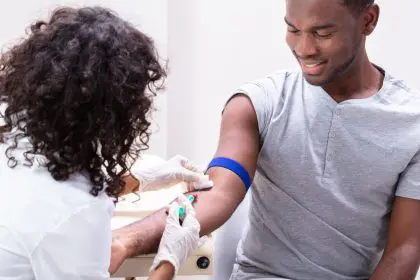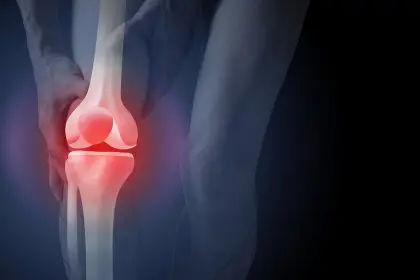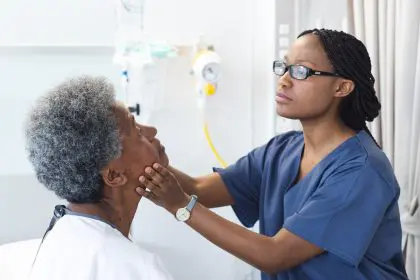When Michael Harrison noticed a small lump near his left nipple, he dismissed it as nothing serious. “Men don’t get breast cancer,” he thought, echoing a common misconception that nearly cost him his life. Three months later, a diagnosis of stage 2 breast cancer transformed his understanding of a disease many men never consider a threat to their health.
The hidden reality of male breast cancer
The numbers tell a story few recognize. With approximately 2,800 new cases expected this year in America alone, male breast cancer emerges as an overlooked yet increasingly significant health concern. While relatively rare compared to other cancers affecting men, its impact proves devastating when detection comes too late.
Medical professionals across the country report a troubling trend: men typically wait longer to seek medical attention for breast-related symptoms compared to women, often leading to more advanced stages at diagnosis. This delay stems largely from a lack of awareness that men can develop breast cancer at all.
Warning signs men often miss
Unlike women, who regularly perform breast self-examinations, men rarely check their chest area for potential warning signs. Dr. Rachel Martinez, an oncologist at Memorial Sloan Kettering Cancer Center, emphasizes that early detection dramatically improves survival rates. Key warning signs include:
A hard lump beneath the nipple area often serves as the first indicator of potential breast cancer in men. Unlike typical fatty tissue, these lumps feel firm and don’t move easily when touched. Any persistent lump warrants immediate medical attention, regardless of size.
Changes in nipple appearance or unexpected discharge raise immediate concerns. While some men experience normal variations in their nipples, sudden changes in shape, position, or the presence of any discharge require professional evaluation.
Skin changes around the breast area, including dimpling, puckering, or redness, signal potential underlying issues. These visible alterations often indicate changes in breast tissue that require medical investigation.
Understanding risk factors
Genetic predisposition plays a crucial role in male breast cancer development. Men carrying BRCA1 or BRCA2 gene mutations face significantly higher risks, highlighting the importance of knowing family history. Those with close relatives diagnosed with breast cancer should consider genetic testing.
Age emerges as another significant factor, with most cases diagnosed in men between 60 and 70 years old. However, younger men aren’t immune, especially those with relevant risk factors. This reality underscores the importance of awareness across all age groups.
Certain medical conditions increase susceptibility to male breast cancer. Klinefelter syndrome, characterized by an extra X chromosome, raises risk levels significantly. Liver disease and obesity also contribute to increased risk through their effects on hormone levels.
The hormone connection
Hormonal balance plays a vital role in male breast cancer development. Conditions or medications that increase estrogen levels or decrease testosterone can create an environment conducive to cancer growth. Understanding this connection helps explain why certain medical conditions and treatments increase risk.
Obesity particularly impacts hormone levels, as fat tissue converts androgens to estrogen. This conversion can create a hormonal environment that promotes breast tissue growth and potentially cancerous changes. Weight management therefore becomes an important preventive strategy.
Breaking the stigma
Social stigma surrounding male breast cancer often prevents men from seeking timely medical attention. Many men feel embarrassed discussing breast-related concerns with healthcare providers, leading to dangerous delays in diagnosis and treatment.
Support groups specifically for men with breast cancer help break this isolation. These groups provide essential emotional support while sharing practical advice about navigating treatment and recovery. Organizations like the Male Breast Cancer Coalition work to raise awareness and connect survivors with those newly diagnosed.
Advanced detection methods
Modern medical technology offers various tools for detecting male breast cancer. While mammograms remain the primary screening tool, ultrasound and MRI provide additional options for investigating suspicious areas. These technologies help healthcare providers make accurate diagnoses and plan effective treatments.
Clinical breast examinations by healthcare professionals prove especially important for men, who may feel uncertain about performing self-examinations. These regular check-ups can detect subtle changes that might otherwise go unnoticed.
Treatment approaches evolve
Treatment options for male breast cancer continue advancing, offering more targeted and effective approaches. Surgery remains a primary treatment, with options ranging from lumpectomy to complete mastectomy depending on cancer stage and spread.
Chemotherapy protocols specifically tailored for male breast cancer show promising results. These treatments consider the unique aspects of male breast tissue and hormone profiles, potentially improving outcomes compared to traditional approaches.
The role of hormone therapy
Hormone therapy plays a crucial role in treating many male breast cancer cases. Since most male breast cancers are hormone-receptor-positive, medications that block estrogen’s effects or reduce its production often form part of treatment plans.
Tamoxifen, traditionally used in women’s breast cancer treatment, shows particular effectiveness in men. This medication helps prevent cancer recurrence by blocking estrogen’s ability to stimulate breast cancer cell growth.
Recovery and monitoring
Recovery from male breast cancer treatment requires comprehensive support. Physical therapy helps restore range of motion after surgery, while regular monitoring ensures early detection of any potential recurrence.
Mental health support proves equally important during recovery. Many men struggle with body image issues and emotional challenges following treatment. Professional counseling and peer support groups help address these psychological aspects of recovery.
Prevention strategies
While not all risk factors for male breast cancer are controllable, certain lifestyle changes can help reduce risk. Maintaining a healthy weight, limiting alcohol consumption, and staying physically active contribute to overall breast health.
Regular self-examination becomes crucial for early detection. Healthcare providers can teach proper examination techniques, empowering men to monitor their breast health effectively between medical visits.
Looking ahead
Research into male breast cancer continues advancing our understanding of this disease. Clinical trials exploring new treatments and prevention strategies offer hope for improved outcomes in the future.
Increased awareness remains crucial for reducing diagnosis delays and improving survival rates. As more men share their stories and medical professionals highlight the importance of early detection, the stigma surrounding male breast cancer gradually diminishes.














